Flying Ants vs. Termites: How to Tell the Difference in Salt Lake City
As summer approaches in Salt Lake City, you can visibly find an emergence of flying insects, and flying ants and termites are one of those However, Salt Lake City residences often confused among these aerial creatures due to their similar appearances. Despite being able to fly, they are very different creatures with unique behaviors and roles in the environment.
Physical Characteristics
Flying Ants: Flying ants, also known as alates, belong to various ant species. Their distinctive body is divided into the head, thorax, and abdomen. Their bodies are constricted at the waist, giving them an apparent “waistline.” Flying ants have two wings, with the front pair larger than the hind pair.
Termites: Termites, on the other hand, have a more uniform body structure. Their bodies consist of a head, thorax, and abdomen, but they lack the pronounced waistline that flying ants possess. Termites have straight antennae and two pairs of wings equal in size and shape.
Wing Characteristics
Flying Ants: One distinct characteristic of flying ants is their wings. The wings of flying ants are asymmetrical—the front wings are more substantial, while the hind wings are smaller and more delicate. This feature creates a distinct visual contrast when the ant is in flight.
Termites: Although termites also possess two pairs of wings, their wings are uniform in size and shape. They are equal in length and have a translucent appearance. Unlike flying ants, termites’ wings do not exhibit a noticeable size difference.
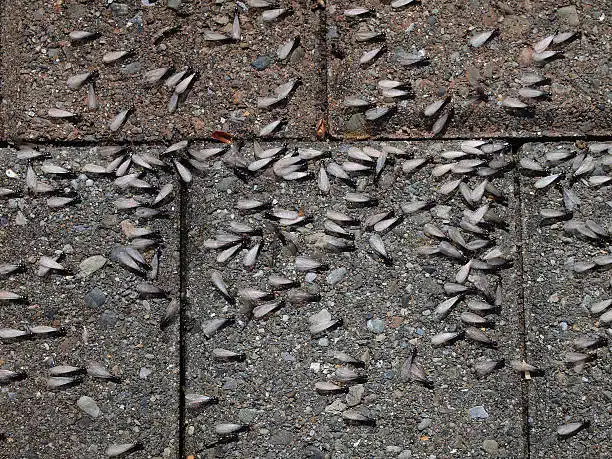
Antennae Shape
Flying Ants: Flying ants have elbowed or bent antennae that are more pronounced than the straight antennae of termites. This attribute is an excellent indicator to distinguish between the two species.
Termites: Termites have straight antennae without any bends or curves. This characteristic is helpful when differentiating them from flying ants.
Behavior and Ecology
Flying Ants: In Salt Lake City, flying ants are often seen during mating flights. These flights typically occur during warmer months and are crucial to the ants’ reproductive cycle. After mating, male flying ants die, while fertilized female flying ants shed their wings and search for suitable nesting sites to establish new colonies.
Termites: Termites also engage in mating flights, commonly referred to as “swarms.” Specific weather conditions often trigger these swarms and are crucial for establishing new termite colonies. Unlike flying ants, male and female termites survive the swarming process, shedding their wings once they find a suitable location to start a colony.
Wood-Damaging Behavior
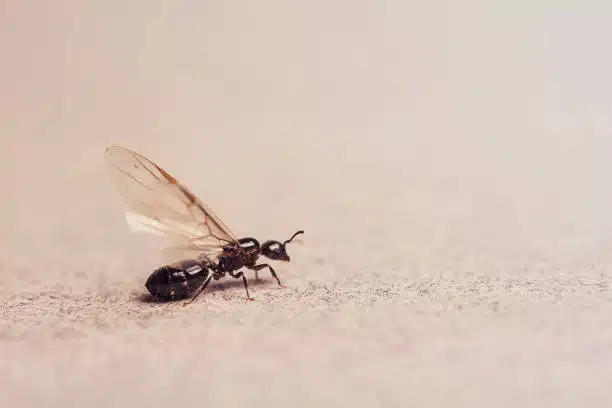
Termites: One of the most critical differences between flying ants and termites is their ecological roles. Termites are infamous for their ability to damage wood structures and materials. They feed on cellulose found in wood, causing potential harm to buildings and other wooden structures. Termite infestations require prompt attention to prevent extensive damage.
Flying Ants: Flying ants are not known for causing damage to wood. Their main function is reproduction and colony establishment, which helps maintain the ecosystem’s natural balance by promoting nutrient cycling and supplying food for other animals.
Effective Ways to Get Rid of Flying Ants and Termites in Salt Lake City
Although, flying ants and termites are mostly the same in some factors, dealing with flying ants and termites in Salt Lake City requires different eradication methods.
For flying ants:
- Start by sealing entry points, as their flights are often tied to mating rituals.
- Remove potential food sources and keep areas dry to discourage their presence.
- Consider using non-repellent insecticides to eliminate them at the source.
Contrarily, termites demand a more targeted approach. Regular inspections of your property for mud tubes and damaged wood are crucial. If infestation is confirmed, consulting with professional termite exterminator in Salt Lake Cityl is advised. These experts pest control professionals may employ methods such as bait systems, liquid termiticides, or even heat treatments, depending on the severity of the infestation.
In both cases, prevention remains key. Address moisture issues, repair leaks promptly, and ensure proper ventilation to deter these pests. You can protect your Salt Lake City home from ants and termites by being aware of the distinctive behaviours of flying ants and termites and taking appropriate action.
Related Articles
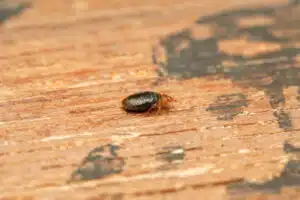
Tick vs. Bed Bugs: Differences and Similarities
Understanding the differences between two common blood-sucking pests, ticks and bed bugs, is important. We want to make sure you know exactly what kind of pests you’re dealing with,
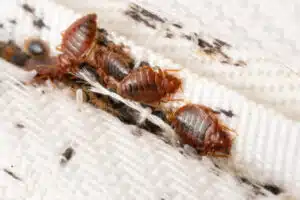
Where Do Bed Bugs Come From, and How to Prevent Them? A Guide for Salt Lake Residents
Bed bugs can be a major nuisance and cause various physical and emotional problems, including skin irritation, anxiety, and sleep disturbances. In Salt Lake City, bed bugs are a growing concern, especially in apartment buildings, hotels, and other high-density living spaces. But where do bed bugs come from, and how can you prevent them from infesting your home or property?
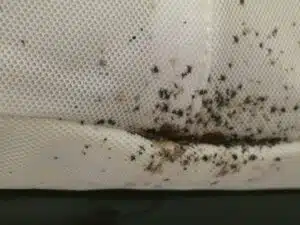
Are All the Tiny Black Bugs in My Bed Bed Bugs?
Sleeping is one of the things that we look forward to after a very long day. We recharge ourselves by sleeping by the end of the night to be refreshed the next day. But we can be disturbed even during our sleep by pesky pests crawling and hiding where we sleep. That’s terrifying, right? Pests that are known to annoy us during our sleep are bed bugs. They are usually found where humans and other pets sleep. Bed bugs can be almost anywhere in the world – even in your Saltlake home! They can be annoying because they suck your blood and leave you with an itch and bumps in the infected area. So blood attracts them, even the blood of other animals. Therefore, you should conduct bed bug removal if you have them. If you find bugs on your beds, you might think they are bed bugs. But are they?

Can Bed Bugs Live in Your Car?
Bed bugs are small, flat, and oval-shaped insects that feed on the blood of humans and animals. During the day, bed bugs hide in cracks and crevices around beds, furniture, and baseboards. You can also find them in mattresses, bed frames, blankets, carpets, and other fabric items throughout your home. While it is possible for bed bugs to infest your car, they’re less likely to do so than inside a house or other structure.
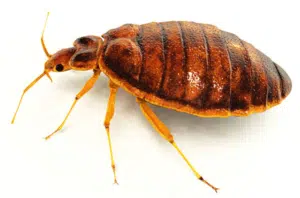
How to Find Bed Bugs in Your Home
Bed bugs are small, blood-sucking that feed on human and animal blood. They belong to the family Cimicidae, contain over 100 species, and have been around for millions of years.

Can Bed Bugs Jump?
Bed bugs are a common household pest that can be difficult to get rid of. These tiny insects can live in any crevice or crack in your home and feed on blood.
